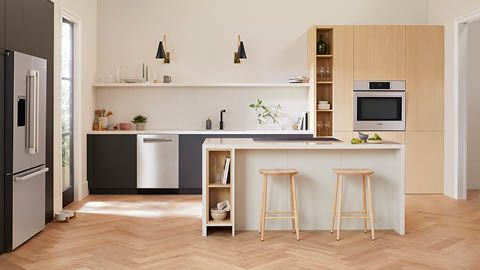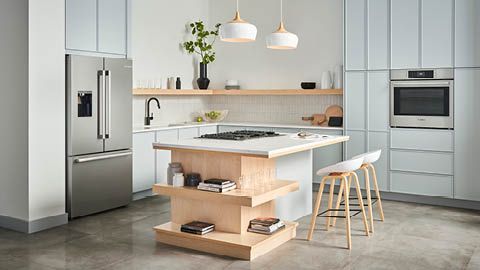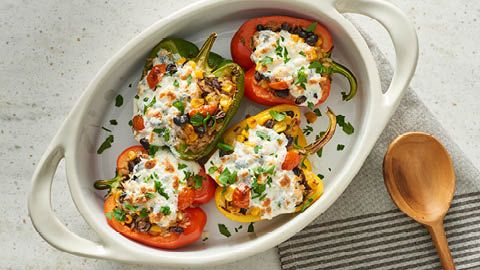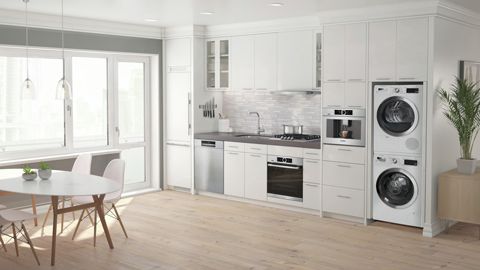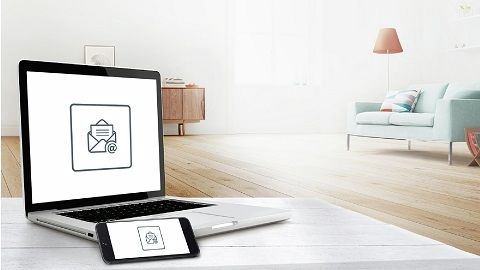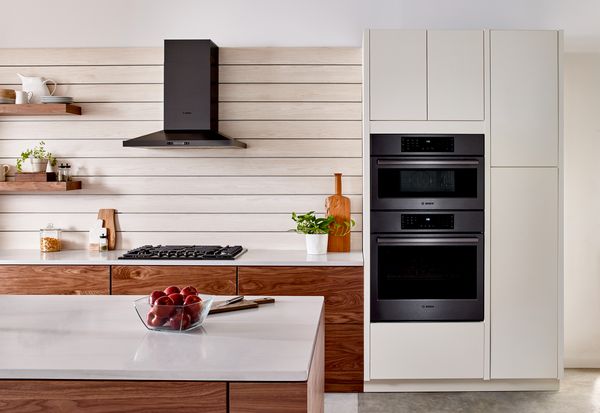
Before using your oven for the first time, follow our simple tips to make sure you get the best experience from your appliance:
- Oven must be properly installed by a qualified technician before use.
- Remove all packing materials from inside and outside the oven.
- While cool, wipe with a clean, damp cloth and dry.
- There may be a slight odor during the first few uses; this is normal and will disappear.
- Use proper bakeware for optimum cooking results (see below for more information on selecting the right bakeware).
- Read and understand all safety precautions and Use and Care Manual information prior to operating.
Top Oven FAQs
What should I do before turning on Self Clean Mode?
Always remove all racks from the oven before activating the self-clean feature. Telescopic racks will get damaged if they left in the oven during self-cleaning. They will get stuck and you won’t be able to pull them out.
Make sure the oven vents are clear and unblocked. These vents release hot air. It’s normal to see hot air or steam escaping from these vents.
I see a code with an E. What does it mean?
If you see an “E” with a number on the display (ex: E30), press any key to stop the beeping. This is an error code message. Reset the oven by turning it off at the breaker. Wait 30 minutes, then turn the breaker on. The oven should return to normal. However, if the error code appears again, please take note of it and call Bosch Customer Service at 1-800-944-2904.
My baked goods are either underdone or overdone. What could be causing this?
Check your oven's baking capability with a simple "bake test“. This is one of the many quality tests that each Bosch oven undergoes prior to leaving the factory. Watch this video to see how you can check your oven's baking capability.
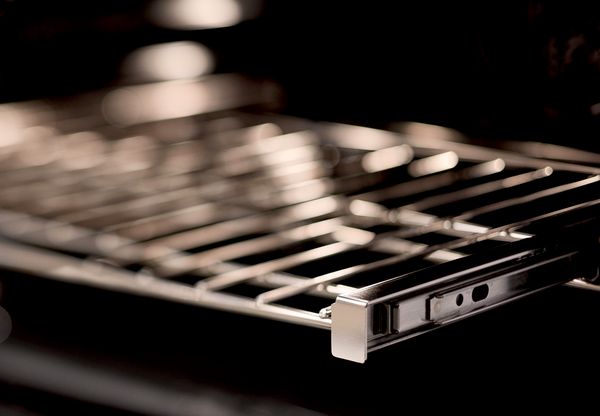
Rack Position Recommendations
Rack position 6 (highest usable position): best for hamburgers, steaks
Rack position 5: best for toasting bread, broiling most meats, melting cheese
Rack position 4: best for thicker meats
Rack position 3: best for broiling poultry, most baked goods on a cookie sheet or baking pan using a single rack, frozen convenience foods, cakes, casseroles, frozen pizza
Rack position 2: best for small roasts or poultry, bundt cakes, pies, breads
Rack position 1 (lowest position): best for large roasts, turkey, angel food cake
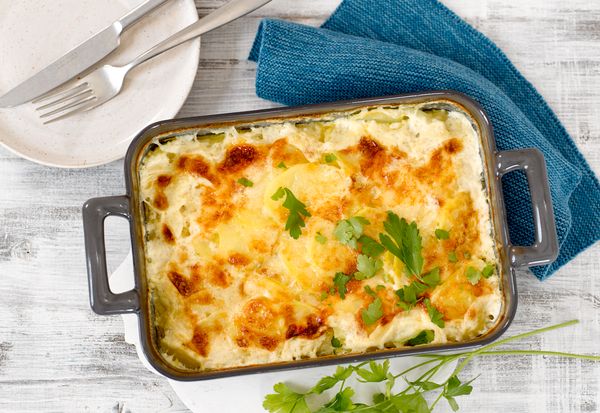
Selecting Different Baking Pans
1. Glass baking dishes
Glass baking dishes absorb heat. Reduce oven temperature 25° F when baking using glass dishes. Preheat the oven before adding glass baking dishes.
2. For tender, light, golden-brown crusts, use light, anodized or shiny metal bakeware.
3. For browner, crispier crusts, use dark, rough or dull pans (nonstick or anodized) since they absorb heat well. Some manufacturers recommend reducing the temperature 25º F when using this type of pan. Follow manufacturers' recommendations.
4. Insulated cookie sheets or bakeware will increase the length of cooking time.
Note: Do not keep empty pans or pizza stones in the oven during cooking as this could change the cooking performance. Store pans outside the oven.
Selecting different cooking modes
Read on for more information about each cooking mode, and the best mode to select based on what you're baking. Note: some cooking modes are not available on all models.
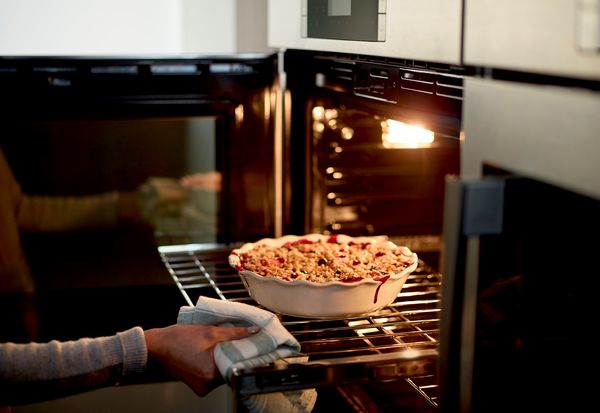
Bake Mode
Bake Mode
Bake is cooking with dry, heated air. Both the upper and lower elements cycle to maintain the oven temperature.
Select Bake when cooking: a variety of food items, from pastries to casseroles.
Convection Bake Mode
Convection Bake Mode
Convection Bake is similar to Bake. Heat comes from the upper and lower heating elements. The main difference in convection baking is that the heat is circulated throughout the oven by the convection fan. The result? Even, golden brown results on all racks. In addition, there is a slight decrease in cooking time which means you can speed up dinner.
Select Convection Bake when cooking: cakes, bar cookies, breads
Tips:
1. Reduce recipe temperature by 25° F if Auto Convection Conversion is not activated.
2. Place food in shallow, uncovered pans such as a cookie sheet without sides.
3. For cakes use rack positions 2 and 5.
4. If baking more than one pan on a rack, allow at least 1” to 1 1/2” of air space around the pan. Stagger pans so that one is not directly above the other.
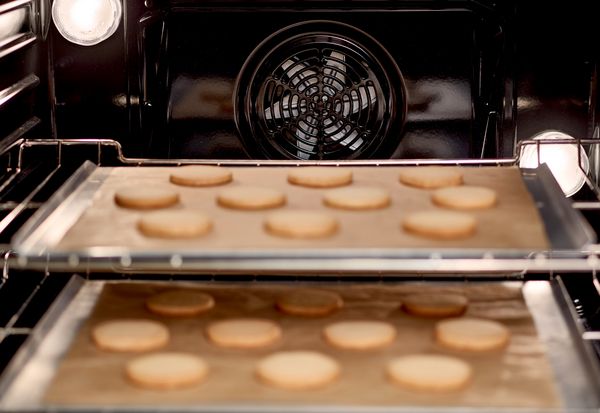
Convection Multi-Rack Mode
Convection Multi-Rack Mode (Genuine European Convection)
Multi-Rack mode cooks with heat from a third element behind the back wall of the oven. The heat is circulated throughout the oven by the convection fan.
The result? Even browning and time savings since you can use multiple racks at one time, all while achieving beautifully even golden results.
Select Convection Multi-Rack when cooking: individual serving-sized foods such as cookies, cupcakes, biscuits, muffins.

Pizza Mode
Pizza Mode
In Pizza mode, heat from the upper and lower elements is circulated throughout the oven by the convection fan.
Select Pizza mode when cooking: fresh or frozen pizza
Tips:
When baking a frozen pizza:
For a crispy crust, place pizza directly on the rack.
For a softer crust, use a pizza pan.
When proofing pizza dough, coat dough with olive oil and cover it in a bowl tightly with plastic wrap to prevent crust formation.
Sprinkle cornmeal on the pizza pan to prevent sticking. If using a pizza paddle, sprinkle the paddle liberally with corn meal for ease in transferring the dough to the pan.
If par baking handmade pizza dough, prick the dough with a fork before baking.
If using a pizza pan, choose a dark, perforated pan for a more crisp crust and a non-perforated pan for a softer crust.
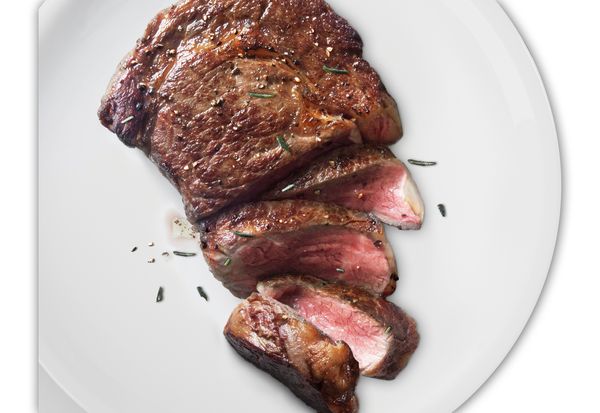
Roast Mode
Roast Mode
Roast uses both the upper and lower elements to maintain the oven temperature. Roasting uses more intense heat from the upper element than the lower element. This results in more browning of the exterior while the inside remains especially moist.
Roast is best suited for meat and poultry and less tender cuts of meat.
Cleaning and Care Tips for your Oven
To clean the exterior
Use mild, soapy water and a soft cloth. Dry with a soft cloth then apply the Bosch Stainless Steel Conditioner in the direction of the stainless steel grain. Don’t apply it to logos and control labels or markings. Also use the Bosch Degreaser to remove tough grease residue.
- DO NOT use any stainless steel cleaners or conditioners on black stainless steel. Black steel can simply be cleaned with mild, soapy water and a soft cloth.
- DO NOT use any chlorine-based cleaners, abrasive cleaners or cloths.
- Watch this video to learn more.
To clean the interior
Simply follow the directions in your owner’s manual for self-cleaning. Remove all racks and pans from the oven before activating the self-cleaning feature. For spot cleaning, use the Bosch Oven & Grate Cleaner to remove tough, burnt-on deposits.
